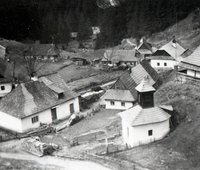An important mining village near Banská Bystrica, known primarily for the mining of copper ore. Archaeological findings confirm the mining of copper ore already in the Eneolithic. The development of mining and the golden period of mining represented the period and functioning of Turzo-Fugger company (15th-16th centuries). In the second half of the 18th century, most of the ore deposits were exhausted, mining continued until 1888, when the mines were closed. In 1957, the construction of finishing mill began, which was opened in 1964. Copper was obtained from old pile material and from the nearby location of Piesky, from where it was imported through a tunnel. Part of the population was engaged in timber harvesting and wood processing. In 1883, bobbin lace work school for women was opened in Špania Dolina. Currently, the village has preserved miner's folk houses, the early Gothic Church of the Transfiguration from the 13th century, a miner's clapper from the 16th century, a unique mine water supply system, mining works - daily imperial adit, Mann Fajtová adit, Maximilián shaft, which is accessible to tourists as part of the educational mining trail.





